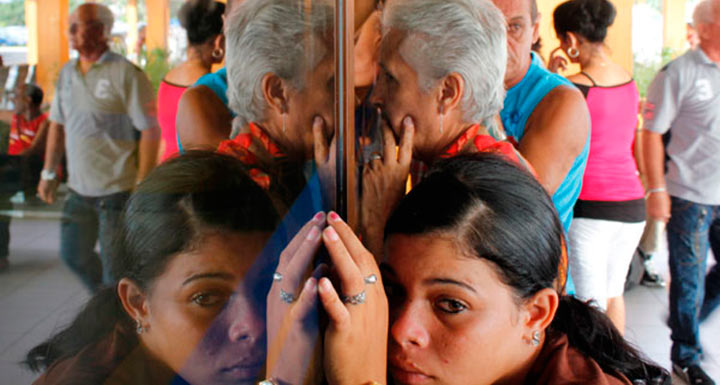
Cuban women emigrate, seeking a future
Helen Hernández Hormilla, a Cuban researcher on gender issues, recently published an article in the website of the News Service for the Latin American and Caribbean Woman about Cuban women who emigrate. Progreso Weekly has redacted that article, which shows how emigration has proceeded in the past several years, as well as the repercussion it has had in an aging Cuban society that has low birth rates.
More and more women are projecting their lives outside Cuba, either for economic reasons, to rejoin their families, to excel, or to acquaint themselves with new cultures.
They account for more than half of the annual emigration since 1995. According to data from the National Office of Statistics and Information (ONEI) cited by the author, more than 263,000 women left Cuba, definitively or temporarily, between 2002 and 2012.
During 2012, they constituted 52 percent of the 46,662 people who left the country, the highest number of female emigrants since 1980.
In a survey done in 2009, sociologist Marta Núñez noticed an increase in the number of young unaccompanied emigrants who generally decide to have children after they’ve inserted themselves into the countries of destination.
For a country with a fecundity rate of 1.7 children per woman and 18.7 percent of its almost 11.2 million inhabitants over 60 years old, feminine emigration during a fertile age implies a demographic challenge that influences its low birth rate.
To many Cuban women, the United States represents a safer destination, given the opportunities granted by the Cuban Adjustment Act. According to that 1966 law, Cuban emigrants who arrive in the U.S. may automatically apply for political asylum. They are given financial support and legal documentation and are granted residence after one year in the U.S.
This condition, along with the historical immigration ties, make the U.S. the main receptor of Cuban emigration, with 1.8 million immigrants of Cuban origin. Of them, about 983,000 were born in Cuba and 52 percent of them were women, according to the 2010 Census.
Qualified emigrants
The higher levels of education, professionalism and officiousness of Cuban women differentiate them from other migrants, and occasionally place them at a certain advantage, in the view of Antonio Aja, director of the University of Havana’s Center for Demographic Studies.
Women account for 66 percent of Cuba’s professional and technical workforce and 64 percent of the graduates from higher education, according to the ONEI.
According to Aja, Cuban emigrant women tend to settle in urban areas or developed cities, working in public or private service jobs, always utilizing the existing social networks of Cuban or Latin American origin.
Generally, they are most likely to maintain ties with their families in Cuba and send more remittances than the men, Aja says.
Toward circular emigration
With the enactment of Decree-Law No. 302, which in January 2013 amended the 1976 Immigration Law, the possibilities to leave and re-enter the country became more flexible and varied.
Even without gender-related data, the ONEI published in its 2013 Statistical Annual a positive migration balance for the first time since 1964.
According to that document, the difference between departures and arrivals in 2013 was 3,302 persons, who basically were concentrated in Havana.
Nevertheless, official figures in late 2013 said that, in the 10 months following the immigration reform, 257,518 trips abroad were made by 184,787 persons, some of them accounting for more than one departure.
Of these, 66,510 traveled to the United States and 40 percent of them returned, according to The Associated Press. The data could indicate a greater number of temporary emigrants as well as a possible return migration.
In a 2013 study, psychologist Osmany Pérez determined an increase in repatriations between 2008 and 2012, when the immigration reform had not yet been instituted.
During that period, 2,127 persons returned from 60 countries to settle definitively in Havana, mostly people 40 years and over who left Cuba beginning in 2000.
“It would seem that we’re going to have a greater circularity of migrants, but that doesn’t mean that sectors that are key to society, such as women and young people, will not emigrate,” Aja said.
“Cuba will have to function, economically and socially, with a smaller population than it has today (in absolute terms) and a lot older,” the expert said.
Aja believes that the impact of the growing emigration of young women in their reproductive age could be attenuated with a greater economic and social development and that the country’s public policies should be aimed in that direction.
CUBAN EMIGRATION IN FIGURES
• ALMOST 2 MILLION PEOPLE BORN IN CUBA LIVE, TEMPORARILY OR PERMANENTLY, IN OTHER COUNTRIES.
• ONE OF EVERY 4 PEOPLE IN CUBA HAS A RELATIVE WHO HAS EMIGRATED, EITHER TEMPORARILY OR PERMANENTLY.
• CUBAN PERSONS ARE REPORTED IN 146 COUNTRIES, 98 PERCENT CONCENTRATED IN 20 NATIONS TOPPED BY THE UNITED STATES, SPAIN, VENEZUELA AND MEXICO.
• ALTHOUGH IT HAS A CONSIDERABLE POPULATION MOVEMENT, CONSIDERING THE NUMBER OF ITS INHABITANTS, CUBA IS A COUNTRY OF MEDIUM-LOW EMIGRATION IN LATIN AMERICA AND THE CARIBBEAN, BECAUSE IT ACCOUNTS FOR 3.4 PERCENT OF THE TOTAL EMIGRATION FROM THE AREA, ACCORDING TO A 2006 CEPAL REPORT.


